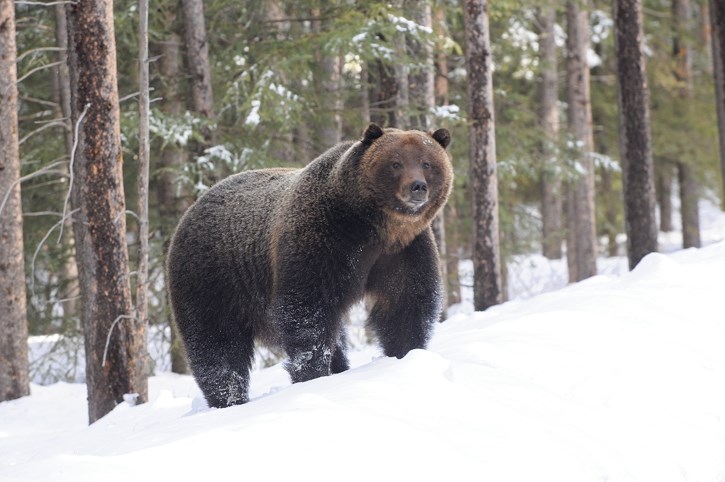Bear 122 is back.
The approximately 300-kilogram grizzly bear, the dominant male in the Bow Valley known as The Boss, was seen on the train tracks along Bow Valley Parkway, Saturday (March 5). It’s believed he’s the first grizzly out of the den.
Wildlife experts say there’s nothing unusual about Banff’s larger male grizzlies emerging from hibernation at this time of year, noting the railway line seems to be the first place bear 122 typically heads in search of grain or animal carcasses.
Steve Michel, human-wildlife conflict specialist for Banff National Park, said he expects more male bears will emerge from the den this month, with females coming out later in spring.
“We’ve been anticipating the first large grizzly bear to wake up in the first week or two of March. This is very typical and certainly what we’ve been seeing over the last decade,” he said.
“It’s a big reminder to everyone that bears are active on the landscape and people should keep that in mind as they are recreating.”
Bear 122 has a reputation as a big, badass bear, but he’s just doing what bears are meant to do. He made national headlines in the summer of 2013 after hunting and eating a black bear close to a busy trail in the Cave and Basin area.
More recently, DNA analysis confirmed 122 is the father of at least five young bruins in the park, and he’s likely fathered more.
Local resident and photographer Amar Athwal was the first to spot bear 122 this year. He was watching a bald eagle when he spotted the large grizzly bear along the parkway near Muleshoe on Saturday (March 5).
“He was looking healthy, but a bit smaller than when he went to sleep,” said Athwal, who photographed the bear shortly before he went into the den.
“I was wondering if I’d see him any day because of all the warm weather we’ve been having.”
Athwal said it’s always great to see bear 122, noting he is an impressive animal to watch.
“I like seeing something at the top of their game. He’s in his prime and seeing an animal like that, I have a lot of respect for him,” he said.
“Some people might get excited when they see Michael Jordan, but I get excited when I see a bear on top of his game.”
When grizzly bears leave their dens in March and in the weeks ahead, food is scarce. They typically spend spring in the valley bottoms searching for food and then move to higher elevation as snow disappears and vegetation greens up later in the season.
Michel said bear 122 appears to hang out in areas around the train tracks for the first month or so out of the den, eating grain that may have accumulated over the winter, or any animal carcasses he can find.
But, he said, it appears spring is a little ahead of schedule this year and there will be more food availability with greenup.
“I expect he’ll probably find all sorts of foraging opportunities and hopefully doesn’t focus exclusively on the railway,” he said.
Michel said Parks Canada has been in contact with Canadian Pacific Railway to get the vacuum truck out to clean up residual grain.
“Grain does tend to accumulate over the winter months and it gets imbedded in the snow between the rails,” he said. “It’s important we get a good cleanup here in spring.”
Previous research has shown that grizzly bears in the Rocky Mountains of Alberta spend, on average, 4.5 months of the year in or near their den sites, which tend to be located at higher elevations.
Large male grizzlies are always the first out in Banff. First reported sightings of grizzly bear 122 was March 19 last year and March 16 the year before, though he may have been out earlier, but just not seen.
Female grizzly bears typically don’t emerge from their dens until later in spring, but bear 148 was moving around the immediate area of her den on a particularly warm weekend in late February.
Michel said staff were able to pick up a telemetry signal from the VHF component of the five-year-old bear’s collar, but there’s been nothing since then to suggest 148 is out of her den.
“It wasn’t a surprise to me during a warm spell of weather that she could become active and be in close proximity to her den and then go back in,” said Michel.
“But if she was to become fully active in late February, get up and forage on the landscape, it would be unusual for a young female grizzly.”
Unlike most hibernators, grizzly bears are aroused easily while in dens.
“Bears are not true hibernators. They really go into a period of deep sleep, which they can easily wake up from. There can be a variety of things that can disturb them,” said Michel.
“Weather events can cause them to wake up, and in the middle of January, bears can wake up and go for a short walk around, and then go back into the den.”
On neighbouring provincial lands, a black bear has been spotted a couple of times in Kananaskis Country since mid-February, which is quite a bit early for black bears to be out of hibernation.
Jay Honeyman, human-wildlife conflict biologist with Alberta Environment and Parks, said there have been no reports of grizzly bears.
“There’s been nothing yet in the Bow Valley here that we’ve seen,” he said.
Locals and visitors alike are reminded to make noise when out and about, watch for signs of bears such as tracks, droppings, diggings, torn up logs and overturned rocks, keep dogs on a leash at all times and carry bear spray and know how to use it.




